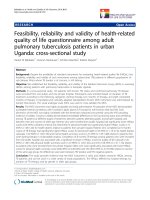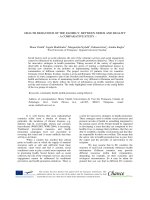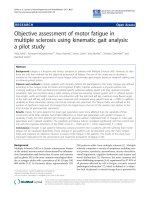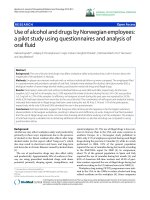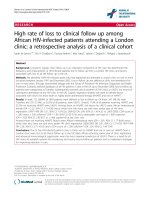High rate of unintended pregnancy among pregnant women in a maternity hospital in Córdoba, Argentina: a pilot study docx
Bạn đang xem bản rút gọn của tài liệu. Xem và tải ngay bản đầy đủ của tài liệu tại đây (207.77 KB, 5 trang )
BioMed Central
Page 1 of 5
(page number not for citation purposes)
Reproductive Health
Open Access
Research
High rate of unintended pregnancy among pregnant women in a
maternity hospital in Córdoba, Argentina: a pilot study
Celina Palena
1
, M Valeria Bahamondes*
1,2
, Verónica Schenk
1
,
Luis Bahamondes
2
and Julio Fernandez-Funes
1
Address:
1
Maternity and Neonatal Hospital, Córdoba, Argentina and
2
Department of Obstetrics and Gynecology, School of Medical Sciences,
University of Campinas (UNICAMP), Campinas, Brazil
Email: Celina Palena - ; M Valeria Bahamondes* - ;
Verónica Schenk - ; Luis Bahamondes - ; Julio Fernandez-
Funes -
* Corresponding author
Abstract
Background: Although Argentina has a new law on Reproductive Health, many barriers continue
to exist regarding provision of contraceptive methods at public healthcare facilities.
Methods: We asked 212 pregnant women selected at random at the Maternity and Neonatal
Hospital, Córdoba, Argentina, to participate in our descriptive study. Women were asked to
complete a structured questionnaire. The objectives were to determine the rate of unintended
pregnancies, reasons for not using contraception, past history of contraceptive use, and intended
future use.
Results: Two hundred women responded to the questionnaire. Forty percent of the women
stated that they had never used contraception and pregnancy was declared unintended by 65%. In
the unintended pregnancy group, almost 50% of women said that they had not been using a
contraceptive method because they were "unaware about contraception", and 25% stated that
their contraceptive method had failed. Almost 85% of women stated that they intended to use
contraception after delivery.
Conclusion: Approximately two-thirds of all pregnancies in this sample were unintended.
Although the data is limited by the small sample size, our findings suggest that our government
needs to invest in counseling and in improving the availability and access to contraceptive methods.
Background
Governmental support for family planning (FP) activities
is relatively new in Argentina, since for many years neither
the federal, state nor municipal governments provided
contraceptive methods in their healthcare facilities. An
extreme example was the province of Córdoba, which is
ranked second highest for its economic performance in
the country, where, in the middle of the 60's, the use of
any modern contraceptive method was prohibited by a
law passed during the military dictatorship. Even after the
democracy was reestablished, conservative members of
society succeeded in upholding this restrictive policy. In
May 2003 the federal government obtained congressional
approval of a reproductive health law that included the
Published: 20 July 2009
Reproductive Health 2009, 6:11 doi:10.1186/1742-4755-6-11
Received: 18 March 2009
Accepted: 20 July 2009
This article is available from: />© 2009 Palena et al; licensee BioMed Central Ltd.
This is an Open Access article distributed under the terms of the Creative Commons Attribution License ( />),
which permits unrestricted use, distribution, and reproduction in any medium, provided the original work is properly cited.
Reproductive Health 2009, 6:11 />Page 2 of 5
(page number not for citation purposes)
provision of modern contraceptive methods at public
health facilities [1]. Almost all the provinces followed fed-
eral guidelines and implemented local legislation.
Nevertheless, many barriers continue to exist for the pro-
vision of contraceptive methods at public healthcare facil-
ities. Although contraceptive methods are currently
provided at many of these facilities, little has been done
with respect to training of healthcare providers in coun-
seling, other activities related to FP and the logistics
related to the use of different contraceptive methods. Con-
sequently, contraceptive methods may be used incorrectly
or inconsistently [2], mainly methods such as oral and
injectable contraceptives. These methods are more
demanding on a woman's day-to-day participation and
may therefore increase the failure rate.
The objectives of this exploratory and descriptive study
were to evaluate a group of pregnant women to determine
in how many cases the current pregnancy was unintended,
to list the reasons reported by these women for not using
contraception, to evaluate previous contraceptive use, and
the intention of contraceptive use after the current preg-
nancy. The findings of this study could be useful to policy
makers in improving FP programs.
Methods
The study was conducted at the Maternity and Neonatal
Hospital of the Province of Córdoba, Argentina and the
protocol was approved by the Institutional Review Board.
A total of 212 women were invited to participate in the
pilot study that took place between December 2006 and
June 2007.
Women were contacted at random at the prenatal clinic
and among women hospitalized regardless of gestational
age. Twelve women refused to participate, consequently,
200 women (94%) were included. Participants were inter-
viewed face-to-face by two of the authors using a pre-
tested questionnaire developed by the authors. The ques-
tionnaire covered socio-demographic information (age,
education, working status), reproductive history, past
contraceptive practice during lifetime, alcohol and smok-
ing habits, and history of sexual and physical violence.
Questions focused on whether or not the woman had
intended to become pregnant at the time of conception,
and whether she intended using contraception following
delivery. Women who stated that their current pregnancy
had been unintended were asked to provide the reasons
for not having used contraception at the time of concep-
tion.
Assessing whether or not a pregnancy is 'unintended' is a
difficult task and involves well-known methodological
problems [3-6]. We therefore constructed an "unintended
pregnancy, yes/no" variable for which the woman's
answer to the following question was used: "Was it your
intention to become pregnant (at that time)? Earlier/at
that time/later/not at all/you have never thought about it"
[7].
The statistical analysis includes a description of the socio-
demographic characteristics of the participants. The rea-
sons for not using contraception and the factors contrib-
uting to contraceptive failure were analyzed for all women
who stated that the current pregnancy was unintended.
Results
Of the 200 women interviewed, 130 stated that their cur-
rent pregnancy had been unintended, while the remain-
ing 70 reported that they had intended to get pregnant.
The mean age was 25.9 (SD ± 7.0 years; range 14–42) and
25.7 (SD ± 7.0 years; range 16 – 40) among women in the
intended and unintended pregnancy group, respectively.
The two groups were similar with regard to educational
level, occupation, smoking status and history of sexual
and/or physical violence. A higher proportion (83.4%) of
women whose pregnancy had been intended reported liv-
ing with a partner (Table 1).
Women whose pregnancy was unintended had a statisti-
cally significantly higher number of previous pregnancies
and deliveries and had more live children compared to
women with intended pregnancies. Moreover, age at sex-
ual debut was lower in the unintended pregnancy group
(Table 2).
Twenty-nine (41.4%) of the women in the intended preg-
nancy group and 50 (38.5%) in the unintended preg-
nancy group declared they had never used contraception
before. The mean age of these women was similar
between the groups (23.7 (SD ± 5.5; range 16 to 40) for
the intended and 23.9 (SD ± 7.8; range 15 to 42 y for the
unintended pregnancy group). In case of contraceptive
use, the most common methods were combined oral con-
traceptives (COC) and condoms. When asked about their
intention for future contraceptive use, the two methods
most often mentioned were COC and intrauterine devices
(IUD) (Table 3). Almost 50% of women in the unin-
tended pregnancy group, who did not use contraception,
stated that they were "unaware about contraception"
(Table 4). One in every four women whose pregnancy was
unintended stated that their contraceptive method had
failed.
Discussion
This study was conducted in the largest maternity hospital
in the province of Córdoba, Argentina were almost 7,000
deliveries are performed annually. The most important
finding was the fact that 65% of respondents stated that
Reproductive Health 2009, 6:11 />Page 3 of 5
(page number not for citation purposes)
their current pregnancy was unintended. Overall, accord-
ing to their answers, these women had more years of
schooling and fewer of these women had a stable partner
at the time of the interview compared to those whose
pregnancy was intended.
The limitations of this study were mainly due to the small
sample size and the convenience sample which may not
be representative of the general situation at the province
or at the country. Argentina has a population of almost 40
million and a total fertility rate (TFR) of 2.5. A woman's
lifetime risk of dying from maternal causes is 1 in 530.
Contraceptive prevalence among women of 15–49 years
of age is 65.3% as reported by the government. According
to the 2001 statistics, the distribution of contraceptive use
was 30.4% for COC, 22% for condoms, 9.5% for IUDs,
and 13.5% for traditional methods [8]. Despite this high
contraceptive prevalence and relatively low TFR, the
results of our exploratory study are not consistent with
these figures. The data collected may not represent the
actual situation of these women, since some may have
been embarrassed to say whether their pregnancy was
intended or unintended [3]. This situation could reflect
on the low number of abortions reported by the women.
Nevertheless, the fact that almost two-thirds of women
reported that their pregnancy was unintended is an infor-
mation that should alert health authorities and mobilize
actions to improve contraceptive services. Data from
France showed that between 20 and 33% of the annual
births are unplanned or unintended [7,9], and in Edin-
burgh, Scotland this figure is only 28% [10,11]. In the
United States, despite the high contraceptive prevalence
the unintended pregnancy rate is still high with almost
half (49%) of all pregnancies reported to be unintended
[12]. The disparity between European countries and the
United States could be explained because in European
countries women have a broader choice of contraceptive
methods and many of them were reimbursed by the social
security; however, in the United States, the range of con-
traceptives is restricted and in many cases the cost is inac-
cessible to low-income women [13].
In our sample, among the women whose pregnancy was
unintended, the main reasons for not having used contra-
ception were: "that they were unaware about contracep-
tion", "contraceptive failure", "inappropriate use", and
"waiting to be provided with a method". Similar results
were observed in a study from France [7]. Contraceptive
Table 1: Selected socio-demographic characteristics of the sample population according to whether or not the pregnancy was
intended.
Variables Intended
(n = 70)
Unintended
(n = 130)
P-value
Age (years ± SD) 25.9 ± 7.0 25.7 ± 7.0 0.8597*
Education n (%) 0.2532***
Some elementary school education 10 (14.3) 8 (6.2)
Completed elementary school 15 (21.4) 24 (18.5)
Some high school education 26 (37.1) 65 (50.0)
Completed high school 14 (20.0) 23 (17.7)
Some college education 5 (7.1) 10 (7.7)
Marital status n (%) 0.0040***
Without a partner 13 (18.6) 53 (40.8)
Living with a partner 57 (83.4) 77 (59.2)
Occupation n (%) 1.0000**
Housewife 54 (77.1) 97 (74.7)
Employed outside the home or student 16 (22.9) 32 (23.9)
* Mann Whitney non-paired test; **Fisher's Exact test; ***Chi-square test
Table 2: Some variables regarding pregnancy and sexual history according to whether or not the current pregnancy was intended.
Variables Intended*
(n = 70)
Range Unintended*
(n = 130)
Range P-value**
Gravida 1.6 ± 0.2 1 – 7 2.6 ± 0.2 1 – 11 0.0115
Para 1.2 ± 0.2 1 – 5 2.1 ± 0.2 1 – 9 0.0095
Abortion 0.3 ± 0.1 0 – 2 0.4 ± 0.1 0 – 5 0.5211
Live children 1.1 ± 0.2 0 – 5 2.1 ± 0.2 0 – 9 0.0035
Age at sexual debut 17.0 ± 0.4 12 – 30 15.9 ± 0.2 11 – 25 0.0089
Number of lifetime partners 2.5 ± 0.2 1 – 7 2.6 ± 0.2 1 – 20 0.6031
* Values are mean ± SEM. ** Mann Whitney non-paired test
Reproductive Health 2009, 6:11 />Page 4 of 5
(page number not for citation purposes)
failure could occur with all contraceptive methods
although is rare with long-acting methods and "perfect
use" methods such as the IUD and subdermal implants
[14]. However, among the women in our sample who
confirmed the use of contraception in the past, the two
most common methods used were COC and condoms,
both of which have a higher probability of method failure
[15]. A study conducted in Norway with women who
claimed to have become pregnant during COC use
revealed that some of these women had stopped using the
pill prior to their last menstrual period, while others were
unable to supply any information at all on their use of
COCs or to provide the prescription for COC use given
just prior to pregnancy [16].
It should also be taken into account that many cases of
unintended pregnancy could result in abortion. The fact
that abortion is illegal in Argentina and access to safe
abortion services is severely restricted, especially for
women from low socioeconomic background may have
contributed to the high number of unintended pregnan-
cies in our sample. Our results show that of women who
declared not having used contraception, 43.8% stated as
their main reason the fact that they "were unaware about
contraception". This reason could be interpreted in a sim-
ilar way as "did not believe I could become pregnant then" as
the main reason for not having used contraception
observed in a Swedish study with women who requested
abortion (and could be interpreted as unintended preg-
nancy) [17]. We believe that both reasons given by
women could be interpreted in a similar way, "unaware
about contraception".
The issue of unintended pregnancy is a challenge in many
countries. The first step towards providing contraceptive
methods is to implement an appropriate legal and politi-
cal framework, which was established in Argentina by cre-
ating the law on reproductive health. However, this is
only the first step. Contraceptive prevalence depends on
other issues. One of them is the provision of methods at
low or no cost to low-income women such as the women
in the present study. In the US, a link has been found
between unplanned pregnancies and abortions and low-
income women [18], and legislation has been approved
to help reduce the gap between women of different socio-
economic levels [19].
Women with no healthcare insurance, attend public
health sector facilities where FP services are mainly pro-
vided by medical doctors and at hospitals. These women
need to schedule an appointment for a consultation, gen-
erally this leads to long delays during which women are
unprotected and may become pregnant. Another situation
to take into account is that often the logistics of contracep-
tive supply are ineffective, and in many clinics certain con-
traceptive methods may be unavailable. Although
legislation states that the provision of contraceptives is
free of charge at public healthcare facilities, in many cases
this policy is not effectively implemented and underprivi-
leged women may still be required to pay for contracep-
tive services despite the supposedly universal access to
contraception [20].
Service providers contribute towards the difficulties
attempting to obtain contraception because they may not
be sufficiently trained to provide enough information
needed to choose a contraceptive method and to use it
correctly. In our study, some women, of the group of
unintended pregnancy, referred as one of the reasons for
not using any contraceptive method was that they were
"waiting for a method" and probably they were referring
to IUD insertion or tubal ligation [21]. Poor women seek-
ing public healthcare are often not in a position to chal-
lenge medical authority or question doctors' decisions,
Table 3: Lifetime history of contraceptive use and intention to
use contraceptives after the present pregnancy according to
whether or not the current pregnancy was intended.
Intended
(n = 70)
Unintended
(n = 130)
Lifetime method used before this pregnancy N (%) N (%)
Oral contraceptive 20 (28.6) 25 (19.2)
Condom 8 (11.4) 30 (23.1)
IUD
#
5 (7.1) 9 (6.9)
Injectable 6 (8.6) 5 (3.8)
Rhythm method 2 (2.9) 11 (8.5)
Never user 29 (41.4) 50 (38.5)
Intention to use
Oral contraceptive 23 (32.9) 31 (23.8)
IUD
#
22 (31.4) 49 (37.7)
Sterilization 5 (7.1) 24 (18.5)
Injectable 6 (8.6) 6 (4.6)
Condom 3 (4.3) 2 (1.5)
Do not know 11 (15.7) 18 (13.8)
#
IUD: Intrauterine device
Table 4: Reasons for not using a contraceptive method given by
the women whose pregnancy were unintended.
Reasons N (%)
Unaware about contraception 59 (45.3)
Contraceptive failure 33 (25.4)
Inappropriate use of contraceptive method 19 (6.9)
Waiting for a method* 8 (6.1)
"Taking a break" from contraceptive use 5 (3.8)
Afraid of side effects with contraception 4 (3.1)
Unable to attend the healthcare facility 2 (1.5)
* Waiting for IUD insertion or tubal ligation
Reproductive Health 2009, 6:11 />Page 5 of 5
(page number not for citation purposes)
and physicians need to make an effort to listen to women
and allow them to express their needs [22]. Contraceptive
failure has been reported to be lower when medical doc-
tors take time to talk to their patients [23].
Family planning services not only depend on the availa-
bility of contraceptive methods, services, and training of
the service providers, it is also important to offer informa-
tion to the general population and especially in schools.
The development and distribution of information, educa-
tion and communication materials represent another
challenge for governments and health policy makers. Lack
of information may increase the rate of contraceptive fail-
ure. In the current sample, more than 40% of women
whose pregnancies were unintended reported that they
had not been using a contraceptive method because they
were unaware that they needed contraception.
The majority of women seeking contraceptive services are
healthy and their objective is to avoid a pregnancy. In the
countries in which abortion is legal, women have a
broader choice; however, in countries such as Argentina
where abortion on request is unavailable, women have to
continue with the pregnancy or undergo abortion which
may be under unsafe conditions with the risk of severe
complications.
Conclusion
Our findings show that almost two-thirds of the women
interviewed in the largest maternity hospital in Cordoba,
Argentina stated that their current pregnancy was unin-
tended and it is not in agreement with currently available
data on contraceptive prevalence. The main reason for
unmet need at the time of conception was that women
were unaware about contraception. Although our data
were limited by the small sample size, it provides infor-
mation to authorities and reinforces the need to invest in
counseling on contraceptive methods in order to reduce
incorrect method use, and make contraceptive methods
available, and accessible to reduce the unmet needs.
Abbreviations
COC: combined oral contraceptives; IUD: Intrauterine
devices; TFR: Total fertility rate
Competing interests
The authors declare that they have no competing interests.
Authors' contributions
All the authors contributed equally in the design, interpre-
tation of the data and review and revise the final manu-
script.
References
1. Republica Argentina, Congreso Nacional: Ley 25673 and Decreto
1282/2003. Programa Nacional de Salud y Procreación Responsable
2003.
2. Trussell J, Vaughan B: Contraceptive failure, method-related
discontinuation and resumption of use: results from the 1995
National Survey of Family Growth. Fam Plann Perspect 1999,
31:64-72.
3. Fischer RC, Stanford JB, Jameson P, DeWitt MJ: Exploring the con-
cepts of intended, planned, and wanted pregnancy. J Fam Pract
1999, 48:117-22.
4. Kaufmann RB, Morris L, Spitz AM: Comparison of two question
sequences for assessing pregnancy intentions. Am J Epidemiol
1997, 145:810-6.
5. Stanford JB, Hobbs R, Jameson P, DeWitt MJ, Fischer RC: Defining
dimensions of pregnancy intendedness. Matern Child Health J
2000, 4:183-9.
6. Barrett G, Wellings K: What is a "planned" pregnancy? Empir-
ical data from a British study. Soc Sci Med 2002, 55:545-57.
7. Bajos N, Leridon H, Goulard H, Oustry P, Job-Spira N, COCON
Group: Contraception: from accessibility to efficiency. Hum
Reprod 2003, 18:994-9.
8. United Nations: World contraceptive use, 2007. USAID, Pop-
ulation Reference Bureau. World Population Data Sheet 2008.
9. Toulemon L, Leridon H: Maîtrise de la fécondité et apparte-
nance sociale: contraception, grossesses accidentelles et
avortements. Population 1992, 47:1-46.
10. Lakha F, Glasier A: Unintended pregnancy and use of emer-
gency contraception among a large cohort of women attend-
ing for antenatal care or abortion in Scotland. Lancet 2006,
368:1782-7.
11. Trussell J, Raymond EG: Preventing unintended pregnancy: let
us count the ways. Lancet 2006, 368:1747-8. Erratum in: Lancet
2006;368:2124
12. Trussell J, Wynn LL: Reducing unintended pregnancy in the
United States. Contraception 2008, 77:
1-5.
13. Demographic and Health Surveys [s ure-
dhs.com/statcompiler]
14. Lopez LM, Steiner MJ, Grimes DA, Schulz KF: Strategies for com-
municating contraceptive effectiveness. Cochrane Database Syst
Rev 2008:CD006964.
15. World Health Organization Department of Reproductive
Health and Research (WHO/RHR) and Johns Hopkins
Bloomberg School of Public Health/Center for Communica-
tion Programs (CCP) INFO Project. Family Planning: A Glo-
bal Handbook for Providers. Baltimore and Geneva: CCP and
WHO; 2007.
16. Skjeldestad FE: Oral contraceptive failures among women ter-
minating their pregnancy. Acta Obstet Gynecol Scand 2000,
79:580-5.
17. Larsson M, Aneblom G, Odlind V, Tydén T: Reasons for pregnancy
termination, contraceptive habits and contraceptive failure
among Swedish women requesting an early pregnancy ter-
mination. Acta Obstet Gynecol Scand 2002, 81:64-71.
18. Finer LB, Henshaw SK: Disparities in rates of unintended preg-
nancy in the United States, 1994 and 2001. Perspect Sex Reprod
Health 2006, 38:90-6.
19. Gold RB: Rekindling efforts to prevent unplanned pregnancy:
a matter of 'equity and common sense'. Guttmacher Policy
Review 2006, 9:2-7.
20. Hwang AC, Grimes DA, Shields WC: Universal insurance cover-
age for contraceptives: a public health imperative. Contracep-
tion 2004, 70:357-8.
21. Brown SS, Burdette L, Rodriguez P: Looking inward: provider-
based barriers to contraception among teens and young
adults. Contraception 2008, 78:355-7.
22. Ranjit N, Bankole A, Darroch J, Singh S: Contraceptive failure in
the first two years of use: differences across socioeconomic
subgroups. Fam Plann Perspect 2001, 33:19-27.
23. Rosenberg M, Waugh MS: Causes and consequences of oral con-
traceptive noncompliance. Am J Obstet Gynecol 1999, 180:276-9.



